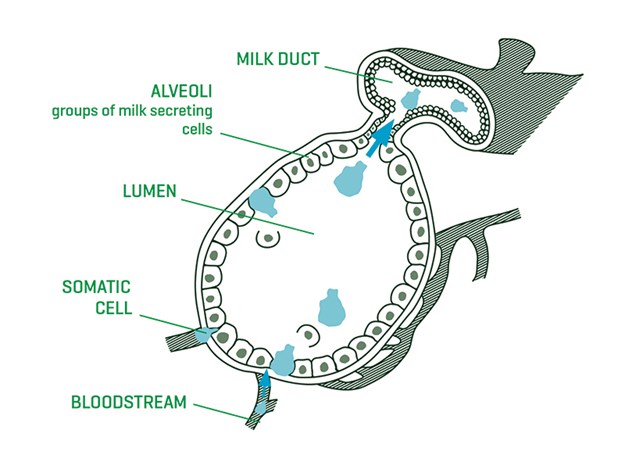Farm advice: Does OAD double milk SCC?
Does switching from twice-a-day (TAD) to once-a-day (OAD) milking affects somatic cell counts (SCC) and the number of mastitis cases?
 |
|
Jane Lacy-Hulbert
|
To answer these questions, we need to understand how somatic cells get into milk. Somatic cells are a natural component of milk. They play a crucial role in the cow’s immune system, helping to protect the udder from infection.
Alongside these, there are different types of immune cells, as well as some epithelial cells (those on the inner and outer surfaces of a cow’s skin and organs) that are shed into milk all the time. These cells move through the lining of the mammary gland, through channels known as ‘tight junctions’ connecting the epithelial cells. This process stops milk from leaking back into underlying tissues and reaching the bloodstream.
When bacteria are detected in milk, large numbers of immune cells flood into the milk, and SCC rises sharply as the inflammation opens the tight junctions. Once the infection has been cleared up, the inflammation subsides, and the junctions tighten again.
How does TAD to OAD impact SCC?
A less dramatic version of this inflammation happens when we switch a cow from TAD to OAD milking. But this change is usually mild and temporary, lasting one to two days. So long as there are no bacteria present, the junctions tighten up again over the next few days.
So, the answer to whether switching to OAD milking doubles milk SCC is
yes and no: SCC at the cow level may increase (and possibly double), but the impact at a herd level will depend on the current situation.
For herds where the SCC is under control (i.e., <150,000 bulk SCC and no clinical cows in the herd) with good systems operating to detect clinical mastitis, then the SCC will only lift slightly, say by 50,000 cells/mL. So, getting the SCC under control before switching to OAD is the key.
 |
|
When a somatic cell moves from the bloodstream into the lumen, it damages the milk secretion cells, making the alveoli less productive
|
How does TAD to OAD impact mastitis?
The chance of an increase in mastitis cases depends on the balance between two competing factors:
- Less frequent milking means fewer chances for bacteria to enter open teats since the teats are connected less often to the milking machine.
- However, milk is held in the udder for longer between milkings, giving more time for bacteria to grow.
This makes good milking practices and machine function even more important.
Learn more at dairynz.co.nz/mastitis.
Myth: Switching cows from TAD to OAD doubles milk SCC.
Busted: SCC does rise slightly (and the risk of mastitis may increase if bacteria are present), but the SCC is unlikely to ‘double’.
Find new and used farm machinery for sale in NZ
Keep up to date in the industry by signing up to Farm Trader's free newsletter or liking us on Facebook




.jpg)
.jpeg)

.jpg)
.jpeg)
.jpg)
.jpeg)

.jpg)
.jpg)
.jpg)
.jpg)
.jpg)

